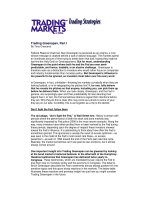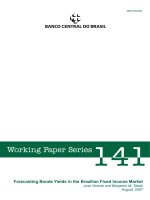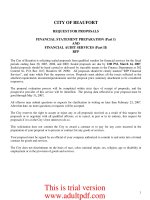R21 fixed income portfolio management part i
Bạn đang xem bản rút gọn của tài liệu. Xem và tải ngay bản đầy đủ của tài liệu tại đây (1.15 MB, 43 trang )
Reading 21
Fixed Income Portfolio Management – Part I
www.irfanullah.co
Graphs, charts, tables, examples, and figures are copyright 2014, CFA Institute. Reproduced
and republished with permission from CFA Institute. All rights reserved.
Contents
1. Introduction
2. Framework for Fixed Income Portfolio Management
3. Managing Funds Against a Bond Market Index
4. Managing Funds Against Liabilities
www.irfanullah.co
2
2. Framework for FixedIncome Portfolio
Management
www.irfanullah.co
3
3. Managing Funds Against a Bond Market Index
3.1 Classification of Strategies
What type of investors
might follow this strategy?
3.2 Indexing (Pure and Enhanced)
3.3 Active Strategies
3.4 Monitoring/Adjusting Portfolio and Performance Evaluation
www.irfanullah.co
4
3.1 Classification of Strategies
Passive Style:
Manager has no reason
to disagree with market
expectations
1. Pure Bond Indexing (or full replication approach)
2. Enhanced Indexing by Matching Primary Risk Factors
3. Enhanced Indexing by Small Risk Factor Mismatches
Active Style:
Manager believes he has
superior forecasting and/or
valuation skills
4. Active Management by Larger Risk Factor Mismatches
5. Full-blown Active Management
www.irfanullah.co
5
3.2 Indexing (Pure and Enhanced)
• Indexed funds have lower fees than actively managed accounts
Why
Index?
• Outperforming market index consistently is difficult
• Broad based index portfolios provide diversification
How do you select the benchmark index?
www.irfanullah.co
6
General Considerations in Selecting an Index
Market value risk of portfolio and benchmark index should
be comparable
Given a normal yield curve and a risk-averse investor should we
go with a long duration or short duration index?
Income risk should be comparable
Credit risk should be comparable
Liability framework risk should be minimized
www.irfanullah.co
7
www.irfanullah.co
8
Manager’s Indexed Portfolio
Mimics
Benchmark Bond Market Index
Mimics
Market of All Bonds
(e.g. Lehman Brothers Aggregate Index)
Risk in Detail: Risk Profiles
Risk profile: detailed tabulation of index’s risk exposures
Changes in the yield curve represent a major source of risk for the bond market
a) Parallel shift
b) Twist
c) Curvature
More sources of risk..
www.irfanullah.co
9
Exhibit 3: Typical Fixed Income Exposures
www.irfanullah.co
10
Strategies for Constructing a Portfolio
Cell Matching Technique (also called Stratified Sampling)
Divide benchmark into (weighted) cells that represent qualities that should reflect
the risk factors of the index
A-Rated 5-year
Corporate Bonds
(30%)
5-year Govt.
Bonds
(30%)
Agency MBS
(40%)
Select bonds from each cell to create portfolio
Multifactor Model Technique
Use set of primary risk factors that drive bond returns
1. Duration
2. Key Rate Duration and PV Distribution of Cash Flows (match portfolio’s cash flow
PV with that of benchmark)
www.irfanullah.co
11
Other risk factors that drive bond returns (cont…)
3. Sector and Quality Percent
4. Sector Duration Contribution
5. Quality Spread Duration Contribution
6. Sector/Coupon/Maturity Cell Weights
7. Issuer Exposure
www.irfanullah.co
12
Tracking Risk
Active Return = Portfolio Return – Index Return
Tracking Risk = Stddev (Active Return)
Example 2/Exhibit 4
www.irfanullah.co
13
Tracking risk arises from mismatches between a portfolio’s risk profile and benchmark’s risk profile
Examples of mismatches:
1. Portfolio duration. What if benchmark duration is 5 and portfolio duration is 5.5?
2. Key rate duration and present value distribution of cash flows.
3. Sector and quality percent.
4. Sector duration contribution. Say sector % matched but duration different…
5. Quality spread duration contribution
www.irfanullah.co
14
Spread duration describes how a non-Treasury security’s price will change due to
widening or narrowing of the spread
Spread duration for a 60-bond portfolio and benchmark index based on sectors
www.irfanullah.co
15
www.irfanullah.co
16
Enhanced Indexing Strategies
Index no transaction costs Portfolio transaction costs Index return > portfolio return
Minimize difference through enhancements
•
Lower cost enhancements
•
Issue selection enhancements
•
Yield curve positioning
•
Sector and quality positioning
– Corporate bonds with maturity < 5 years
– Periodic over or underweighting of sectors (treasuries vs. corporate bonds)
•
Call exposure positioning
Example 4
www.irfanullah.co
17
3.3 Active Strategies
Active managers look for large positive active return and are willing to accept high
active risk
Active managers need to…
1.
Identify which index mismatches are to be exploited
2.
Extrapolate the market’s expectations (or inputs) from the market data
3.
Independently forecast the necessary inputs and compare these with the market’s
expectations
4.
Estimate the relative values of securities in order to identify areas of under or
overvaluation
www.irfanullah.co
18
Total Return Analysis and Scenario Analysis
Total return is the rate of return that equates the future value of the bond’s cash flows with
the full price of the bond. It takes into account:
a) Coupon income
b) Reinvestment income
c) Change in price
Formula:
Total is based on a single interest rate term structure forecast
What if the forecast is wrong?
www.irfanullah.co
19
Also use scenario analysis because…
1. You can assess distribution of possible outcomes
2. Analysis can be reversed… start with range of acceptable outcomes and then
determine interest rate movements (inputs) that would result in desirable outcome
3. Contribution if individual components (parallel shift, twist) can be evaluated
4. Can evaluate a range of strategies
www.irfanullah.co
20
Section 3 Summary
www.irfanullah.co
21
4 Managing Funds Against Liabilities
www.irfanullah.co
22
4.1 Dedication Strategies
Cash flow matching provides future
funding of a liability stream from coupon
and mature principal payments of the
portfolio
Immunization aims to construct a portfolio which, over
a specified horizon, will earn a predetermined return
regardless of interest rate changes
www.irfanullah.co
23
Immunization Strategies
Implementation of an immunization strategy depends on the type of liabilities that the
manager is trying to meet:
1. Single Liability
2. Multiple Liabilities (DB Plan Promised Payouts)
3. General Cash Flows
Classical Single Period Immunization
1. Specified time horizon
2. Assured rate of return during holding period to a fixed horizon date
3. Insulation from the effects of interest rate changes on the portfolio
value at the horizon date
Price change Reinvestment income
www.irfanullah.co
24
You sell a 5 year GIC
7.5% guaranteed
$9,642,899 $13,934,413
In you invest $9,642,899 in par
value bonds with a YTM of 7.5%
are you covered?
Are you concerned about rates
up or rates down?
www.irfanullah.co
25









